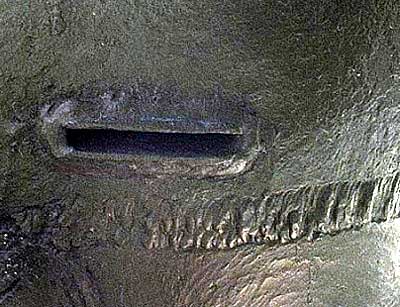1⁄35How to Create Accurate Weld Effects
16
Comments
Example 2: 90° fillet weld (concave)
|
In our next example we shall perform the same process as described above but
this time we shall replicate a concave weld. The same process for creating a
roll of milliput and priming the sectional surfaces with water is as previously. In this case though instead of blending the edges of the milliput into the adjoining areas, we force the milliput into the corner surfaces as smoothly as possible. This we have done here by the use of the end of a paintbrush. Once we have the milliput in the shape we desire we must once again wet the surface and leave to allow a skin to form. |
|
| To create the weld seam in this case we must use the CURVED back edge of the weld tool. This is used in exactly the same manner as in the previous weld but in this case we will leave our ridges in a concave shape. This is illustrated in Pic 7 before the final blend of the edges into the surrounding sections has been carried out. The image does not show too clearly the concave nature of the final shape of the weld but rest assured this is the exact shape you get. This can be compared to similar welds on vehicles and once painted and washed/weathered will blend in very well with the surrounding detail. |  |
Example 3: 90° butt weld
| In the last of the simple weld examples we will cover a butt weld. In this case the template to be used is two sections of styrene with a small gap left between them, backed by another styrene strip. Here we are trying to replicate the gap between sectional surfaces that would naturally exist or that has been replicated on a kit using a panel line scriber. This template can be seen in Pic 8. |
|
|
In Pic 9 we can see the milliput roll has been pressed into our gap between our
weld sections. Don’t worry if part of the milliput is squeezed out over the
edges as this is an effect that we want. Again make sure the surface has been
layered with water and the surface left to harden. To create our weld we use our tool as before using the OPEN end of the tool. This time we press down through the milliput so that all excess material is squeezed out to the sides. What this should leave is a weld that is at the level of the sections that is being welded and can be seen in Pic 10. What we do next is scrape away the excess material and again with some water and a paintbrush, gently blend in the edges of the weld to the sectional sides. This should leave a weld that has an appearance to that as in pic 11 (Note there is still some edge clean up to be carried out here). If we then compare the finished butt weld to an example from a real vehicle (in this case a soviet SU100) we can see how accurately this process can be in replicating such effects. |

|
Comments
I read this in a book once,but maybe it would work in a different way,In the book it said to slightly push a pin(not heated) in to the pastic,so it forms a bulge around the tiny ark,that traps the paint and makes a rivit,maybe if you scribed very lightly with that pin to make the letters,and painted,you would get the same affect
SEP 04, 2003 - 02:08 PM
Thanks Jim! Your article serves to inspire me to continue with weld seam additions. I've almost given up with the styrene rod method (making it gooey & soft first using thin plastic cement then scribing the weld pattern with a hobby knife). The cement tends to somewhat ruin the surrounding plastic, making the model's surface finish look terrible. The next weld seams on my models will definitely be made of Milliput.... Cheers!
Dennis
SEP 06, 2003 - 01:47 PM
Like learning there are more ways to do a difficult task. That's one thing I can always count on here and that's learning new techniques and even getting ideas on areas I hadn't even considered before.
SEP 06, 2003 - 06:20 PM
This is a good article. Wonderfully illustrated. Quality job. Thank you !
SEP 17, 2003 - 08:51 AM
Excellent Article... Made sure I printed it out for future referance!!
:-)
SEP 17, 2003 - 01:26 PM
Another informative and well written article. Keep em' comin.
Joshua Weingarten
IDF Armour Group
LINK
SEP 18, 2003 - 11:18 AM
Another informative and well written article. Keep em' comin.
Joshua Weingarten
IDF Armour Group
LINK
SEP 18, 2003 - 11:18 AM
This article still remains a classic. I notice some were asking about welded on writing. I've posted picks of the Abrams welded on numbers before which look far better than the DML numbers. There's a clear rubbery substance (I can't remember the name of it as it dried up at least ten years ago) that you can purchase at art supply stores. It can be applied with a syringe (through the needle even) and takes paint very well. I'll see if I can find it next week when I get home, unless someone else knows what it's called.
MAR 02, 2010 - 01:02 PM
Copyright ©2021 by Lee Lloyd. Images and/or videos also by copyright holder unless otherwise noted. The views and opinions expressed herein are solely the views and opinions of the authors and/or contributors to this Web site and do not necessarily represent the views and/or opinions of Armorama, KitMaker Network, or Silver Star Enterrpises. All rights reserved. Originally published on: 2003-08-27 00:00:00. Unique Reads: 82033














